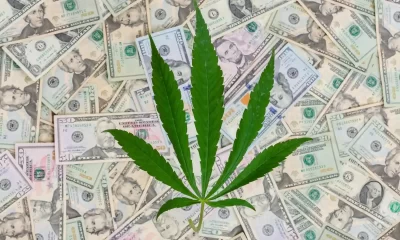Business
Indoor marijuana cultivators share pre-harvest tips for lighting, nutrients, temperature and irrigation

Such preparation applies to indoor, greenhouse and outdoor grows, each of which is subject to unique challenges.
While indoor cultivation is ostensibly the most controlled environment, problems in indoor grows can quickly spin out of control if cultivators don’t plan meticulously and watch their crops vigilantly to keep plants on schedule.
“For all of our crops, we have targets for everything that needs to happen in their day-to-day life span. All of our schedules work on a harvest schedule,” said Nic Robertson, vice president of operations in Massachusetts for multistate operator 4Front Ventures, which is headquartered in Phoenix.
“If I want to produce 300 pounds of Blue Dream on the menu on this date, I need to have it tested by this date, which means I need to harvest it by this date, transplant it by this date and so on and so forth.”
There is some flexibility to tweak those schedules if a crop needs to finish earlier or later than expected to get the best possible flower.
But changes to harvest schedules can’t be made without considering the possible impacts on cannabis plants.
“No single decision that we make is isolated from all the rest of the scheduling,” Robertson said.
Ryan Cook, executive vice president of operations at Florida-based Jushi Holdings, another multistate operator, agrees that planning and preparation make for a successful harvest day.
“A lot of work is done on the front end so that, by the time we get to harvest, there’s less subjective decision-making at the back end,” Cook explained.
“We’ve got full-on harvest prediction planners where we can see when the clones we took this week are going to be harvested.”
While cultivators who plan their indoor harvests weeks in advance have their own ways of preparing, there are several commonalities they use to ensure a successful harvest. These include adjustments to:
- Lighting.
- Temperature and humidity.
- Nutrients.
- Watering and flushing.
- Defoliation.
The changes often depend on specifics of the cultivation environment – size of growing room and plant canopy, strains being grown, type of HVAC system and lights being used – and growers will have to figure out what pre-harvest tactics work best in their respective environments.
Lighting
Indoor cannabis growers often make pre-harvest adjustments to light intensity and spectrum.
During the first week of the flowering phase, Jushi starts the LED light intensity at 700 micromoles (micromoles are a unit used to measure brightness).
By the time the plants hit week three of flowering, cultivation staffers have moved the lights roughly 10 to 12 inches closer to the canopy, increasing the micromoles to anywhere from 1,000 to 1,400, according to Josh Malman, Jushi’s vice president of cultivation.
They maintain that level of light intensity until the final week of flowering, when light intensity is returned to 700 micromoles.
“That helps reduce the temperature on the canopy a little bit and helps to maintain those terpenes from volatizing off near the end of the cycle,” Malman said.
Some cultivators also like to expose their plants to extra red light.
By introducing a few minutes of red-spectrum light per day, growers can go from the typical flower-phase light cycle of 12 hours for both light and darkness to a cycle of 13 or so hours of light and 11 hours of darkness.
The additional light, some growers say, increases yields and promotes a richer cannabinoid and terpene profile.
Heat and humidity
Temperature and humidity levels also can be lowered as harvest approaches, with the aim of beginning to dry out the plants.
Less moisture preserves terpenes and protects against microbial contamination, which is more common late in the flowering phase, when plants are big and near full maturity.
Lowering temperatures inside a grow room toward the end of the flowering phase can benefit flower quality because it mimics the cooler temperatures of fall.
“It helps those buds tighten up a little bit. They start to notice it’s getting cold, so they start to tighten up. They get a little bit harder, they get a little denser – and that’s obviously what we’re looking for in our final product,” Robertson said.
He warned, however, that “when you get too cold in a room, the dew point is going to promote a certain type of moisture in the air that promotes mold and pathogenic growth.”
Toward the end of the flowering phase and shortly before harvest, Robertson said he likes to maintain temperatures around 72 degrees; he also dials humidity back to 40%-45%.
Marco Malatrasi, director of production at Fluent Cannabis, which operates in Florida, Pennsylvania and Texas, also lowers his temperatures from the high 70s during the first several weeks of the flowering phase to the low 70s for the last few weeks of flowering.
“Most varieties will show a sensitivity to cold, and they’ll produce more anthocyanins,” Malatrasi said, referring to the purple and red pigments that appear on some cannabis strains.
Jushi, which maintains a temperature range of 78-82 degrees during the first several weeks of flowering, drops the temperature to 68-70 degrees near the end of the cycle, late in week seven or week eight.
“Lower temperature/lower humidity are keeping microbials low,” Malman said, “And we’re not volatizing terpenes with high temperatures near the end.”
Lowering humidity near the end of the flowering phase also helps reduce moisture in the flower as harvest nears, said Frank Golfieri, the Massachusetts-based director of cultivation for multistate cannabis operator Insa.
Golfieri likes to gradually reduce temperatures to about 60 degrees and 50% humidity by harvest.
Depending on the strain, he could start reducing temperature and humidity a few days or a couple of weeks before harvest.
Nutrients
Another important change that cultivators make as harvest nears is their use of nutrients.
“Harvest is an important time to cut back on certain nutritional inputs and maybe increase others,” Robertson said. “Hands down, the most important nutritional input that will direct how the plant is growing at any stage is going to be nitrogen.
“If we don’t start to lower our nitrogen, that plant is going to hormonally think at some point that it still wants to produce some sort of vegetative growth, meaning it will expand in size or wants to put more work into its family’s production.”
Growers at 4Front typically start reducing nitrogen inputs about halfway through the flowering cycle “in anticipation of harvest, to make sure that the plant is focusing its energy in all the right places,” such as bud, resin and cannabinoid production, Robertson said.
“Usually at that stage is where we start to skew the overall balance of nutrients that are being delivered to the plant. Where we start to drop nitrogen is where we start to increase phosphorus and potassium. Because there are three major nutrients: the N, P and the K. We start to drop the N, we start to increase the P and the K.”
Cook from Jushi cautioned, “If you reduce nitrogen too early, you may cause some early senescence (deterioration) of leaves, which potentially causes microbial or bacterial fungal risks.”
Watering and flushing
Another important part of pre-harvest prep is watering and, to an even greater extent, flushing the plant of nutrients. Flushing usually takes place in the last week or final days before harvest, the idea being that nutrients can negatively affect cannabis taste and how the flower burns.
“I think our recipe, like a lot of others, does have a natural taper in nitrogen as you make your way through the crop cycle, and it never really goes away until we start that hard flush, which is generally just a pH’d RO (reverse osmosis) water or pH’d city water that’s going into the crop,” Malman said.
But Malman and other growers caution against reducing or eliminating nitrogen too early.
“If you stop giving it food, it starves. It starves quickly, and you can see that plant start to decline. When that plant starts to decline, you get natural senescence for the flowers and the leaves. You start to get risks for detritus. So, we drive this hard (with nutrients) till close to the end,” he said.
“And the last three to five days, (we) give it a rest, because you’re probably not getting much growth out of it anyway at that point. But if you pull back two weeks early, you won’t get your crop to the finish line in a healthy manner. So, we really keep that going through most of the crop.”
As harvest nears – and especially as growers get to flushing time – it’s important to monitor a plant’s moisture content, Malman said.
As plants get older, they don’t drink at the same pace and don’t need the same amounts of water to propel their buds to grow.
But knowing the moisture content is critical. So, Jushi has sensors installed in rockwool and coco cubes, and the sensors are connected to the grow’s fertigation systems.
In less sophisticated facilities, Jushi cultivation workers use handheld moisture meters to determine how much to reduce water before harvest.
“It’s also important not to overwater in the final weeks, which can be difficult if you’re also trying to do flushing. The key is to find a balance,” Golfieri said.
“You’re trying to be careful to not flush the plant too heavily, because every time you do that, you’re stressing the plant because you’re putting a lot more moisture into the room that you have to pull out, which could cause issues. So, even toward the end, I’m almost cutting back, making sure it’s nice and even.”
Golfieri also noted that if plants are fed correctly throughout their life spans, “You won’t need to do much heavy flushing, which can be bad, because it involves using too much water, which can cause other problems when there is too much moisture in the roots.”
He added: “We don’t want to flush too hard, where it takes away a lot of the smell and even the color of a flower. We try to do it at a point where it’s just right.”
Source: https://mjbizdaily.com/marijuana-cultivators-share-pre-harvest-tips/
Business
New Mexico cannabis operator fined, loses license for alleged BioTrack fraud

New Mexico regulators fined a cannabis operator nearly $300,000 and revoked its license after the company allegedly created fake reports in the state’s traceability software.
The New Mexico Cannabis Control Division (CCD) accused marijuana manufacturer and retailer Golden Roots of 11 violations, according to Albuquerque Business First.
Golden Roots operates the The Cannabis Revolution Dispensary.
The majority of the violations are related to the Albuquerque company’s improper use of BioTrack, which has been New Mexico’s track-and-trace vendor since 2015.
The CCD alleges Golden Roots reported marijuana production only two months after it had received its vertically integrated license, according to Albuquerque Business First.
Because cannabis takes longer than two months to be cultivated, the CCD was suspicious of the report.
After inspecting the company’s premises, the CCD alleged Golden Roots reported cultivation, transportation and sales in BioTrack but wasn’t able to provide officers who inspected the site evidence that the operator was cultivating cannabis.
In April, the CCD revoked Golden Roots’ license and issued a $10,000 fine, according to the news outlet.
The company requested a hearing, which the regulator scheduled for Sept. 1.
At the hearing, the CCD testified that the company’s dried-cannabis weights in BioTrack were suspicious because they didn’t seem to accurately reflect how much weight marijuana loses as it dries.
Company employees also poorly accounted for why they were making adjustments in the system of up to 24 pounds of cannabis, making comments such as “bad” or “mistake” in the software, Albuquerque Business First reported.
Golden Roots was fined $298,972.05 – the amount regulators allege the company made selling products that weren’t properly accounted for in BioTrack.
The CCD has been cracking down on cannabis operators accused of selling products procured from out-of-state or not grown legally:
- Regulators alleged in August that Albuquerque dispensary Sawmill Sweet Leaf sold out-of-state products and didn’t have a license for extraction.
- Paradise Exotics Distro lost its license in July after regulators alleged the company sold products made in California.
Golden Roots was the first alleged rulebreaker in New Mexico to be asked to pay a large fine.
Source: https://mjbizdaily.com/new-mexico-cannabis-operator-fined-loses-license-for-alleged-biotrack-fraud/
Business
Marijuana companies suing US attorney general in federal prohibition challenge

Four marijuana companies, including a multistate operator, have filed a lawsuit against U.S. Attorney General Merrick Garland in which they allege the federal MJ prohibition under the Controlled Substances Act is no longer constitutional.
According to the complaint, filed Thursday in U.S. District Court in Massachusetts, retailer Canna Provisions, Treevit delivery service CEO Gyasi Sellers, cultivator Wiseacre Farm and MSO Verano Holdings Corp. are all harmed by “the federal government’s unconstitutional ban on cultivating, manufacturing, distributing, or possessing intrastate marijuana.”
Verano is headquartered in Chicago but has operations in Massachusetts; the other three operators are based in Massachusetts.
The lawsuit seeks a ruling that the “Controlled Substances Act is unconstitutional as applied to the intrastate cultivation, manufacture, possession, and distribution of marijuana pursuant to state law.”
The companies want the case to go before the U.S. Supreme Court.
They hired prominent law firm Boies Schiller Flexner to represent them.
The New York-based firm’s principal is David Boies, whose former clients include Microsoft, former presidential candidate Al Gore and Elizabeth Holmes’ disgraced startup Theranos.
Similar challenges to the federal Controlled Substances Act (CSA) have failed.
One such challenge led to a landmark Supreme Court decision in 2005.
In Gonzalez vs. Raich, the highest court in the United States ruled in a 6-3 decision that the commerce clause of the U.S. Constitution gave Congress the power to outlaw marijuana federally, even though state laws allow the cultivation and sale of cannabis.
In the 18 years since that ruling, 23 states and the District of Columbia have legalized adult-use marijuana and the federal government has allowed a multibillion-dollar cannabis industry to thrive.
Since both Congress and the U.S. Department of Justice, currently headed by Garland, have declined to intervene in state-licensed marijuana markets, the key facts that led to the Supreme Court’s 2005 ruling “no longer apply,” Boies said in a statement Thursday.
“The Supreme Court has since made clear that the federal government lacks the authority to regulate purely intrastate commerce,” Boies said.
“Moreover, the facts on which those precedents are based are no longer true.”
Verano President Darren Weiss said in a statement the company is “prepared to bring this case all the way to the Supreme Court in order to align federal law with how Congress has acted for years.”
While the Biden administration’s push to reschedule marijuana would help solve marijuana operators’ federal tax woes, neither rescheduling nor modest Congressional reforms such as the SAFER Banking Act “solve the fundamental issue,” Weiss added.
“The application of the CSA to lawful state-run cannabis business is an unconstitutional overreach on state sovereignty that has led to decades of harm, failed businesses, lost jobs, and unsafe working conditions.”
Business
Alabama to make another attempt Dec. 1 to award medical cannabis licenses

Alabama regulators are targeting Dec. 1 to award the first batch of medical cannabis business licenses after the agency’s first two attempts were scrapped because of scoring errors and litigation.
The first licenses will be awarded to individual cultivators, delivery providers, processors, dispensaries and state testing labs, according to the Alabama Medical Cannabis Commission (AMCC).
Then, on Dec. 12, the AMCC will award licenses for vertically integrated operations, a designation set primarily for multistate operators.
Licenses are expected to be handed out 28 days after they have been awarded, so MMJ production could begin in early January, according to the Alabama Daily News.
That means MMJ products could be available for patients around early March, an AMCC spokesperson told the media outlet.
Regulators initially awarded 21 business licenses in June, only to void them after applicants alleged inconsistencies with how the applications were scored.
Then, in August, the state awarded 24 different licenses – 19 went to June recipients – only to reverse themselves again and scratch those licenses after spurned applicants filed lawsuits.
A state judge dismissed a lawsuit filed by Chicago-based MSO Verano Holdings Corp., but another lawsuit is pending.
Source: https://mjbizdaily.com/alabama-plans-to-award-medical-cannabis-licenses-dec-1/
-

 Business2 years ago
Business2 years agoPot Odor Does Not Justify Probable Cause for Vehicle Searches, Minnesota Court Affirms
-

 Business2 years ago
Business2 years agoNew Mexico cannabis operator fined, loses license for alleged BioTrack fraud
-

 Business2 years ago
Business2 years agoAlabama to make another attempt Dec. 1 to award medical cannabis licenses
-

 Business2 years ago
Business2 years agoWashington State Pays Out $9.4 Million in Refunds Relating to Drug Convictions
-

 Business2 years ago
Business2 years agoMarijuana companies suing US attorney general in federal prohibition challenge
-

 Business2 years ago
Business2 years agoLegal Marijuana Handed A Nothing Burger From NY State
-

 Business2 years ago
Business2 years agoCan Cannabis Help Seasonal Depression
-

 Blogs2 years ago
Blogs2 years agoCannabis Art Is Flourishing On Etsy







